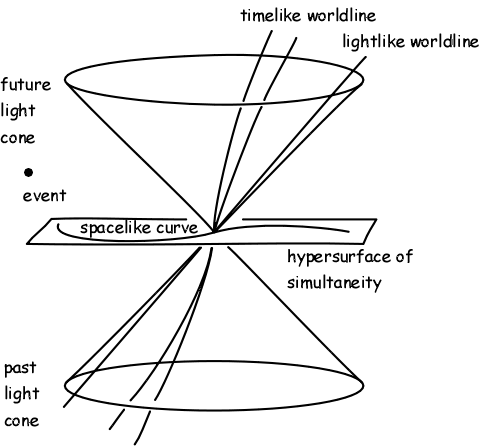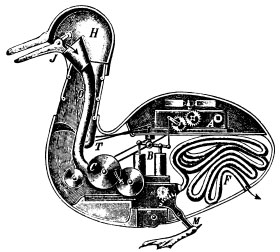| For a pair of entangled particles in the Copenhagen interpretation of quantum mechanics (QM), the measurement of one particle seems to establish a chain of simultaneous causes. Such a chain renders standard QM inconsistent with the reductionism of Einstein, who sought explicitly to permit only temporally ordered causal chains. Halloween is over (and All Hallows Day is here!), but, in a comment over on my post about the philosophy of science, my brother wrote to ask about an experiment regarding spooky action at a distance. I just recently read an article claiming that Chinese physicists were able to place a lower bound on the 'speed' of action-at-a-distance. According to the article the 'speed' has a lower bound of 10,000 times the speed of light.... Yes! |
| | Albert Einstein famously spoke of "spukhafte Fernwirkung" or "spooky action at a distance" when he referred to quantum entanglement of two or more particles. Quantum mechanics was for Einstein bad enough in its description of a single particle. Whether representing a single particle or many particles, the theory (at least according to its standard interpretation, which I refer to below as "QM") implies that the result of an experiment can be indeterminate. In such a case, even if everything knowable about the system be known to the experimenter before the experiment takes place, he still cannot know the result ahead of time. That is indeterminacy. Another issue shows up in a particular kind of system with more than one particle. In representing two or more entangled particles, sharing the same wavefunction, QM implies that the indeterminate result of the measurement of one particle can instantly determine the result of the measurement of another particle, regardless of how far separated (even by light years!) the particles are when the first is measured. Instant (spooky) action at a distance violates the principle of locality, according to which nothing can travel through space faster than some maximum speed, which Einstein had identified as the speed of light. Having eliminated action at a distance from the theory of gravity by replacing Newton's spooky idea of gravity with general relativity, Einstein was forced to confront spookiness again when he helped to flesh out QM. John Bell in 1964 showed that, even if one could find a (hidden-variables) theory that makes a measurement determinate, there exists no such local theory consistent with the predictions of QM. Although, according to QM, the spookiness can not be exploited by technology to send information faster than the speed of light, had Einstein lived longer, he seems likely to have been disappointed at Bell's demonstration that no theory consistent with the predictions of QM could fail to be spooky (even if it did somehow manage to make measurements determinate). The experiment described at www.extremetech.com appears designed to look more carefully than ever before into whether in an experimental sense a system that QM describes as entangled produces measurements that Einstein would classify as spooky. The answer is, apparently, Yes. If the wavefunction be interpreted as actually existing in physical space, then, according to the author of the article, the wavefunction appears to collapse faster than 10,000 times the speed of light and possibly instantly, across 15 km or so. I don't know how to assess whether the research reported in the article be so conclusive as it is claimed to be, but there has been enough research in this area over the last couple of decades to give experimental evidence for what Einstein considered spooky. Even if the result be what the researchers claim, would it really be spooky? Well, it might be spooky to the reductionist, who, like Einstein, thinks that every complex system is just the sum of its parts. There might be other kinds of reductionism, but presently by "reductionism" I mean the classical, relativistic approach of breaking the universe down into individual space-time points (events). Each event influences others only by the time-like movement of a point particle of matter inside the forward light cone and by the light-like propagation of perturbations, both in force fields and in the curvature of space-time itself, along the surface of the forward light cone. This approach reduces everything to points in space-time, tries to identify a single set of rules by which those points can influence each other, and thereby identifies only one mode of causality for such influence, so that every causal sequence is ordered in time. What QM has long suggested and what some of the experiments that fail to rule out QM now suggest is that a two-particle system can in some cases be a radical unity, not just the sum of its parts: In addition to the parts, there is between them an immediate correlation, the entanglement, that spans space and time. To say that a whole is just the sum of its parts is, in terms of classical physics, to say that the behavior of the parts depends at most only indirectly (or else not at all) on the whole. For the reductionist, each part within the whole interacts with another part by the same rules governing the interaction between a part in one whole and a part in some other whole. Drawing a line between one whole and another whole within the universe is at least somewhat arbitrary. The behavior of a part within a whole might seem different from that of a similar part elsewhere, but (according to the reductionist) this is just a consequence of the same rules that apply everywhere; these rules predict that one part, mashed up against another part in some collection that we call a whole, ought in that case to have behavior different from the behavior that the one part would have if it were flying freely through space. So the behavior of the parts depends at most only indirectly on the whole, which is itself only a vague notion; what the behavior depends on directly is a set of forces (the rules) that mediate the interaction between one part and another. To the contrary, QM predicts that the behavior of the parts can depend directly on the whole; in such a case, the whole itself, far from being a vague notion, is precisely the correlation by which the measurement of one part affects the measurement of a different part, even in the absence of any interaction between the parts. This makes sense for a real unity. Suppose that a point particle (like an electron or a photon) really does exist, and suppose that each particle in a pair occupies a different location in space at a given time. Suppose further that, for some reason, the particles together form a real, substantial unity. Not a merely accidental unity, such as that one particle happens to be constrained by a force to remain near the other, but a substantial unity, as though the pair of particles together make a single substance, regardless of what forces (if any) act on either particle. The unity spans space if the unity persist regardless of how far apart the particles drift. The unity spans time if the unity persist until one of the particles undergoes an interaction that fractures the unity. This is just what one might expect from a real unity that has some extension over space and time. Contrary to the idea that a radical unity of distinct things could span space and time, reductionism in physics describes everything as some combination of
To someone who is committed to the reductionist approach in physics, and especially to the idea that causes must be ordered in time, it might seem spooky for QM to imply that two or more particles at different locations in space can be joined together to form an immediate unity. Such a unity would violate time-ordered causality, for the unifying cause, in combination with a measurement at one point in space, has an effect simultaneously at the point of measurement and at a distant point in space. QM suggests that a causal chain, such as
To someone who is comfortable with the idea that a real unity extended over space and time can exist, though, something like the entanglement correlation seems necessary rather than spooky. |



 RSS Feed
RSS Feed